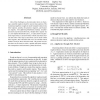Free Online Productivity Tools
i2Speak
i2Symbol
i2OCR
iTex2Img
iWeb2Print
iWeb2Shot
i2Type
iPdf2Split
iPdf2Merge
i2Bopomofo
i2Arabic
i2Style
i2Image
i2PDF
iLatex2Rtf
Sci2ools
FSKD
2007
Springer
2007
Springer
Rough Set Model Selection for Practical Decision Making
One of the challenges a decision maker faces is choosing a suitable rough set model to use for data analysis. The traditional algebraic rough set model classifies objects into three regions, namely, the positive, negative, and boundary regions. Two different probabilistic models, variableprecision and decision-theoretic, modify these regions via l,u user-defined thresholds and α, β values from loss functions respectively. A decision maker whom uses these models must know what type of decisions can be made within these regions. This will allow him or her to conclude which model is best for their decision needs. We present an outline that can be used to select a model and better analyze the consequences and outcomes of those decisions.
| Added | 07 Jun 2010 |
| Updated | 07 Jun 2010 |
| Type | Conference |
| Year | 2007 |
| Where | FSKD |
| Authors | Joseph P. Herbert, Jingtao Yao |
Comments (0)

